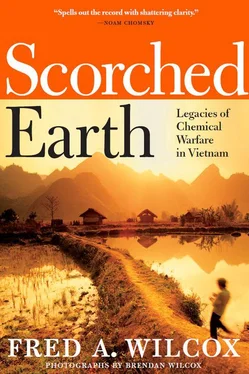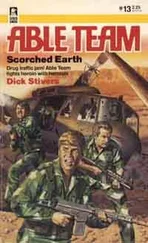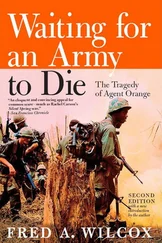Dwernchuk, Wayne L. et. al. “Dioxin Reservoirs in Southern Vietnam—A Legacy of Agent Orange.” Chemosphere 47, no.2 (April 2002): 117–137.
Ginevan, Michael E. et al. “Assessing Exposure to Allied Ground Troops in the Vietnam War: A Quantitative Evaluation of the Stellman Exposure Opportunity Index Model.” Chemosphere 75, no. 11 (June 2009): 1512–1518.
Hall, Wayne. “The Logic of Controversy: The Case of Agent Orange in Australia.” Social Science & Medicine 29, no. 4 (1989): 537–544.
Kalter, Harold. “Teratology in the 20th Century Environmental Causes of Congenital Malformations in Humans and How They Were Established.” Teratology in the Twentieth Century , Elsevier, 2003: 131–282.
Mortelmans, Kristien et al. “Mutagenicity of Agent Orange Components and Related Chemicals.” Toxicology and Applied Pharmacology, 75, no. 1 (August 1984): 137–146.
Palmer, Michael G. “The Legacy of Agent Orange: Empirical Evidence from Central Vietnam.” Social Science & Medicine 60, no. 5 (March 2005): 1061–1070.
Schecter, Arnold et al. “Dioxins: An Overview,” Environmental Research 101, no. 3 (July 2006): 419–428.
———. “Chlorinatead Dioxin, Dbenzofuran, Coplanar, Mono-ortho, and Di-ortho Substituted PCB Cogener Levels in Blood and Semen of Michigan Vietnam Veterans Compared with Levels in Vietnamese Exposed to Agent Orange.” Chemosphere 27 (1993): 241–252.
———. “Dioxin and Dibenzofuran Levels in Blood and Adipose Tissue of Vietnamese from Various Locations in Vietnam in Proximity to Agent Orange Spraying.” Chemosphere, 25 (1992).
———. “Human Adipose Tissue Dioxin and Dibenzofuran Levels and ‘Dioxin Toxic Equivalents’ in Patients from the North and South of Vietnam.” Chemosphere, 20, no. 7–9 (1990): 943–950.
———. “Elevated Body Burdens of 2,3,7,8-tetrachlorodibenzodioxin in Adipose Tissue of United States Vietnam Veterans.” Chemosphere, 18 (1989): 431–438.
———. “Adipose Tissue Levels of 2,3,7,8 TCDD in Vietnamese Adults Living in Vietnam, 1984–1987.” Chemosphere , 18 (1989): 1057–1062.
———. “Levels of 2,3,7,8-TCDD in Silt Samples Collected Between 1985–1986 from Rivers in the North and South of Vietnam.” Chemosphere, 19, no. 1–6 (1986): 547–550.
Verger, R, et al. “Correlation Between Dioxin Levels in Adipose Tissue and Estimated Exposure to Agent Orange in South Vietnamese Residents.” Research, 65, no. 2 (May 1994): 226–242.
APPENDIX 3
VA: Veterans’ Diseases Associated with Agent Orange Exposure
Acute and Subacute Transient Peripheral Neuropathy
A nervous system condition that causes numbness, tingling, and motor weakness. Under the VA’s rating regulations, it must be at least ten percent disabling within one year of exposure to Agent Orange and must resolve within two years after the date it began.
AL Amyloidosis
A rare disease caused when an abnormal protein, amyloid, enters tissues or organs.
B Cell Leukemias
Cancers which affect B cells, such as hairy cell leukemia.
Chloracne
A skin condition that occurs soon after dioxin exposure and that looks like common forms of acne seen in teenagers. Under the VA’s rating regulations, it must be at least ten percent disabling within one year of exposure to Agent Orange.
Chronic Lymphocytic Leukemia
A disease that progresses slowly with increasing production of excessive numbers of white blood cells.
Diabetes Mellitus (Type 2)
A disease characterized by high blood sugar levels, resulting from the body’s inability to respond properly to the hormone insulin.
Hodgkin’s Disease
A malignant lymphoma (cancer) characterized by progressive enlargement of the lymph nodes, liver, and spleen, as well as by progressive anemia.
Ischemic Heart Disease
A disease characterized by a reduced supply of blood to the heart.
Multiple Myeloma
A cancer of specific bone marrow cells that is characterized by bone marrow tumors in various bones of the body.
Parkinson’s Disease
A motor system condition with symptoms that include trembling of the limbs and face and impaired balance.
Porphyria Cutanea Tarda
A disorder characterized by liver dysfunction and by thinning and blistering of the skin in sun-exposed areas. Under the VA’s rating regulations, it must be at least ten percent disabling within one year of exposure to Agent Orange.
Prostate Cancer
Cancer of the prostate, one of the most common cancers among men.
Soft Tissue Sarcoma (other than Osteosarcoma, Chondrosarcoma, Kaposi’s sarcoma, or Mesothelioma)
A group of different types of cancers in body tissues such as muscle, fat, blood, lymph vessels, and connective tissues.*
* Source: United States Department of Veterans Affairs, 2009.
APPENDIX 4
Agent Orange: Important Dates
1940s. Arthur W. Galston, a graduate student at the University of Illinois, discovers that chemicals that inhibit plant growth can also increase the number of floral buds and harvestable pods produced on soybean plants getting ready to flower. Scientific studies on the effects of growth inhibiters continue during World War II at Ft. Detrick, Maryland.
1950. President Dwight Eisenhower refuses to sign an order that would allow the use of herbicides in Korea.
1950s. Research on herbicides continues at Ft. Detrick, Maryland.
1959. The United States military experiments with herbicides at Fort Drum, New York.
1961. President John F. Kennedy approves of using herbicides in Vietnam. Tests of herbicides on the Vietnamese countryside begin in August 1961, and continue through December.
1962. The first shipment of Agent Orange arrives in Vietnam. Systematic testing continues for years.
1965. Operation Ranch Hand, “Only we can prevent forests,” uses Agent Orange in Vietnam.
1966. Professor Arthur W. Galston and twelve colleagues from the American Society of Plant Physiologists send a letter to President Lyndon B. Johnson expressing their concerns that herbicides might harm human beings in Vietnam, and challenging the use of herbicides to destroy food crops.
1967. A team of Japanese filmmakers talk with Vietnamese who live in areas where Agent Orange has been used.
1969. Dr. Bert Pfeiffer and other scientists from the Council of the American Association for the Advancement of Science pass a resolution urging the Department of Defense to “immediately cease all use of 2,4-D and 2,4,5-T in Vietnam.”
1969. Bionetics Laboratories of Bethesda, Maryland, releases the results of its study, completed in 1965, which demonstrates that even in the lowest dose given, 2,4-5-T causes cleft palates, missing and deformed eyes, cystic kidneys, and enlarged livers in the offspring of laboratory animals.
1970. Congress directs the Department of Defense to engage the National Academy of Sciences to conduct a comprehensive study of the ecological and physiological effects of Agent Orange in Vietnam.
1970. On April 15, 1970, Deputy Secretary of Defense David Packard announces the immediate suspension of the use of 2,4,5-T in Vietnam. Also, the Surgeon General reports to the Hart committee on the restrictions placed on 2,4,5-T: suspension of liquid formulation for home use, suspension of all aquatic uses, intent to cancel registration of nonliquid formulations for use around homes and on all food crops.
Читать дальше












